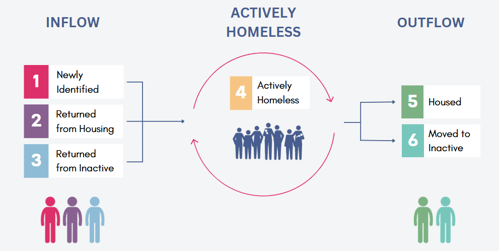By-Name ListLearn how people have been moving in and out of homelessness in Brisbane.Our monthly By-Name List dashboard provides near-real-time data on individual adults, young people, and families with children who are or have been sleeping rough - on the streets, in parks, tents, cars, and/or cycling in and out of motels and emergency accommodation in Brisbane. We also provide historical trends to understand how homelessness has changed in Brisbane over time. |
|
| The Brisbane Zero By-Name List data allow us to measure our progress and advocate for systems changes towards ending homelessness in Brisbane. | |
-
TO TRACK OUR PROGRESS, WE NEED TO UNDERSTAND HOW PEOPLE IN OUR COMMUNITY MOVE IN AND OUT OF HOMELESSNESS.
Specifically, communities can look at six data points:

INFLOW
When a person loses housing and enters into homelessness, they’re part of what we call inflow. Inflow data captures people who are:
- Newly identified, or new to homelessness.
- Returned from housing, or people who experienced homelessness before, got connected with housing, and now are homeless again.
- Returned from Inactive, or people who experienced homelessness before and exited to unknown destinations, and now are homeless again.
ACTIVELY HOMELESS
This includes individuals or families that our collaborating agencies have engaged with, and we know by name rough sleeping - on the streets, in parks, tents, cars or temporary accommodation.
OUTFLOW
Outflow refers to people who have exited homelessness. This includes:
- Housed, or people who have been connected to permanent housing.
- Moved to inactive, or people who exit homelessness without support from the homeless response system, such as finding their own housing, moving out of the community, or entering a long-term stay in an institution.
The Common Screening Tool |
The Australian Homelessness Vulnerability Triage Tool (AHVTT) is the common tool used by all Brisbane Zero members to help homelessness services match housing with the appropriate support for the most vulnerable people experiencing homelessness in their communities.
Additionally, organisations use the collective, de-identified data to advocate for systemic change and resources necessary to end homelessness in our community. |
 |
-
It is a voluntary triage tool based on people’s disclosed information. It is used to match appropriate housing and support services.

The AHVTT provides information on individuals, youth, and families’ demographics, homeless history, social and daily needs, risk and safety, health and wellness. AHVTT data is also stored in the CSnet database with the goal of providing housing and supports need information for every individual, youth, and family in the By-Name List.
Learn more
about the By-Name List, the AHVTT, and the Advance to Zero Framework.

